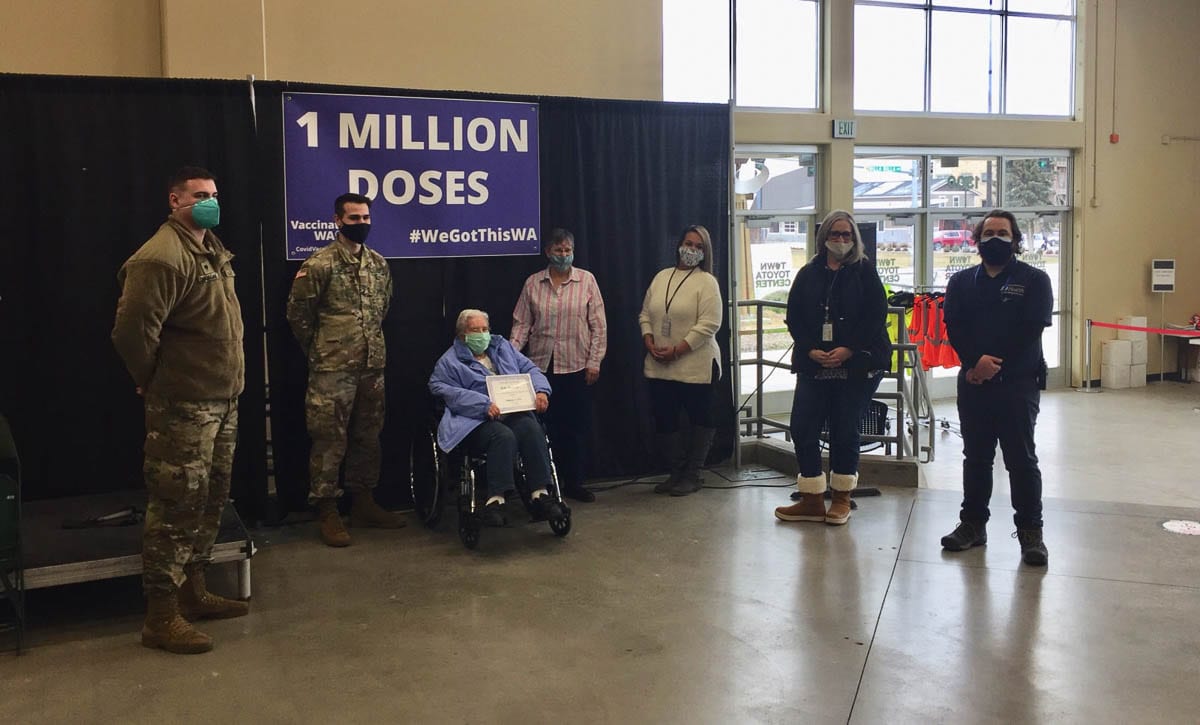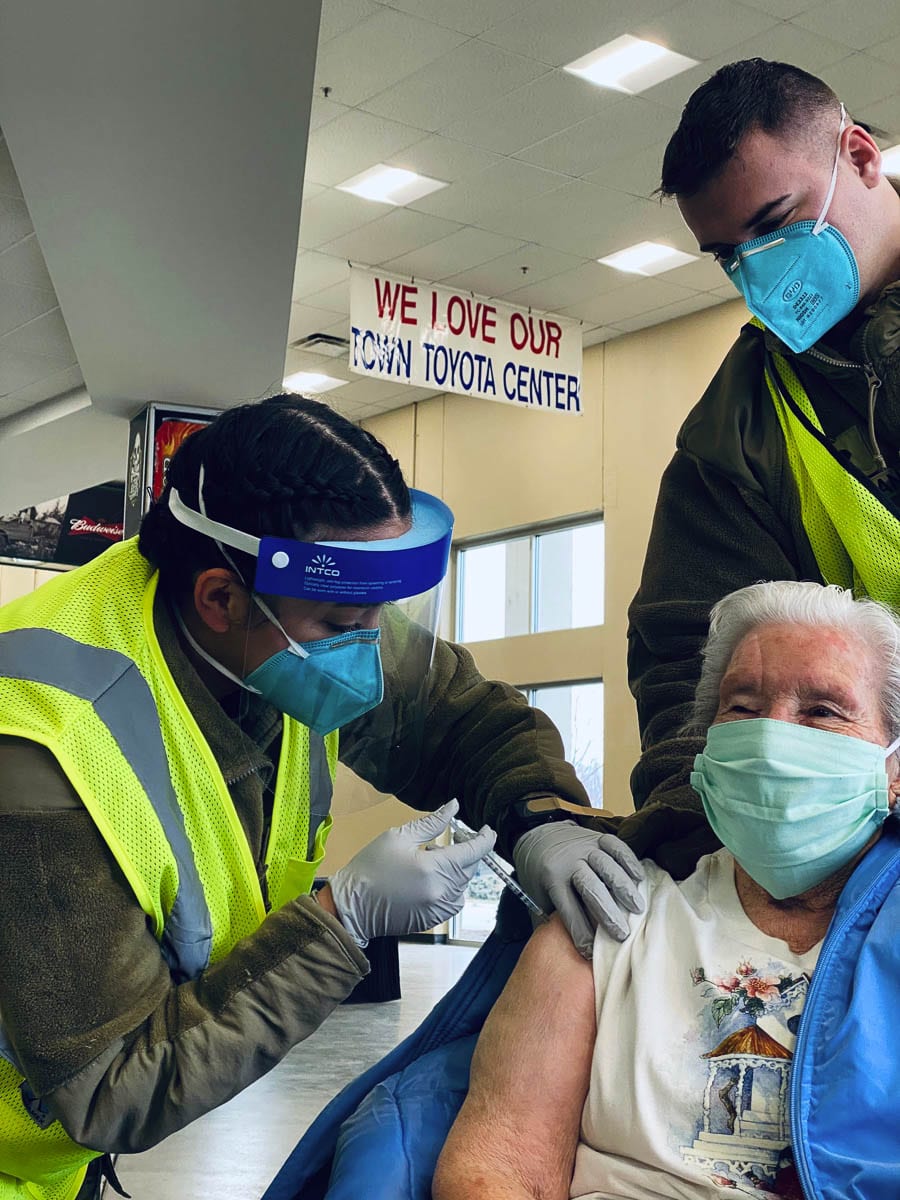The state administered its one-millionth vaccine dose in Wenatchee on Friday
RIDGEFIELD — Plenty of frustration remains for tens of thousands in Washington state still trying to get lined up for a first dose of COVID-19 vaccine, but there are signs of a slow improvement.
On Friday the state officially passed the milestone of 1 million COVID-19 vaccine doses administered. The millionth dose was given to 90-year old Ruby T. at the Wenatchee, Wa. mass vaccination site.
“We are thrilled that 1 million doses of COVID-19 vaccine have been given in Washington state. That means hundreds of thousands of people have gotten their COVID-19 vaccine,” says Umair A. Shah, MD, MPH, Secretary of Health. “But we have so much more work to do to get everyone not just that first dose, but the second. And until we have millions of people vaccinated in the state, we all must continue to wear masks, wash our hands, and watch our social distancing.”

Statewide, mass vaccination sites have distributed over 30,000 doses of vaccine since opening on Jan. 26. That includes an average of 3,000 per week at the Clark County Fairgrounds in Ridgefield, though wintry weather prompted a two-day closure of that site, with canceled appointments rescheduled for Tuesday.
Another bit of good news is that the federal government, which buys the vaccines and ships them to the states, is now providing supply estimates three weeks in advance.
Previously, the state was only learning on Tuesday of each week how much they would receive, then having to work through logistics to determine where doses should be sent, and how many. Providers often didn’t know until Friday afternoon what they would be receiving, making it difficult to schedule appointments.

According to DOH, the state will receive 206,125 doses next week, including 113,800 first doses. That will increase to 240,620 total doses the next week, and 242,360 doses the week of February 28.
“This information allows us to develop a multi-week strategy that helps with consistency and predictability,” the department said in a news release this week. “We hope to have this plan fully in place in the coming weeks.”
Even with the slowly increasing supply, demand is still far outpacing it.
This week, providers requested more than 440,000 doses of vaccine. Requests are based on how many people could be scheduled, and ongoing demand. Many providers have their own lists of people who qualify under Phase 1A or 1B1, which includes 1.7 million people in the state who are frontline medical workers, first responders, or age 65 and older (50+ in multigenerational households).
“Although doses are not where we would like them to be right now, we are optimistic about the future,” DOH said on Thursday. “We have been told by the federal government that allocations for both Pfizer and Moderna will increase in the coming weeks and months.”
A one-dose vaccine created by Johnson & Johnson could also receive an emergency use authorization from the Food and Drug Administration as soon as the end of February. Johnson & Johnson has said they could ship upwards of 100 million doses within weeks of clearing that hurdle.
Confusion over second dose supplies
When Gov. Jay Inslee mandated that providers use vaccine shipments within seven days of receipt and opened eligibility up to over a million more people in late January, many providers had to start using supplies held back for second doses.
That led to a domino effect of first dose shipments later being used to ensure people could get their second shot on time, which led to fewer appointments being available.
This week, DOH said they have been in contact with hospitals across the state in an effort to clear up the confusion and “pave a clear pathway moving forward.”
That includes encouraging providers to schedule a second dose immediately when patients receive their first shot.
People receiving the Pfizer-BioNTech vaccine should be given their second dose 21 days later, compared to 28 days for the Moderna version.
The Centers for Disease Control (CDC) has said that second doses can be scheduled as late as six weeks after the first, with no impact on the overall effectiveness of the vaccine.
Racial data on vaccinations reveals disparity
The Department of Health on Friday also unveiled the first look at vaccinations in the state with a focus on race and ethnicity.
The report noted that Hispanics, who comprise over 13 percent of the state’s population, make up just 4.7 percent of people who’ve received a first dose, and 5.9 percent of people who are fully vaccinated.
Black residents are also underrepresented, but not as sharply. They make up 3.9 percent of the state population, but 2.7 percent of overall vaccinations.
The state has made a more concerted effort to distribute vaccine doses to tribal authorities, meaning American Indian and Alaska Native populations are faring better with vaccinations in terms of percentage of the population.
Race and ethnicity data for those over age 65 show a lower proportion of Whites being vaccinated as a percentage of the population, with other ethnicities had a similar or slightly lower proportion compared to their representation in the state population.
“These data are crucial to understanding how we must balance the need to vaccinate as many Washingtonians as quickly as possible while also promoting equity in the process,” said Shah. “While we have been focusing on both throughout, we must all do more to address these COVID-19 vaccine inequities and related access barriers.”
DOH has also updated their strategies for equitable COVID-19 vaccine distribution, an evolving document intended to inform how vaccine doses are distributed statewide.
There are plans to begin incorporating race and ethnicity data on vaccinations within the state’s COVID-19 data dashboard within the next week.




